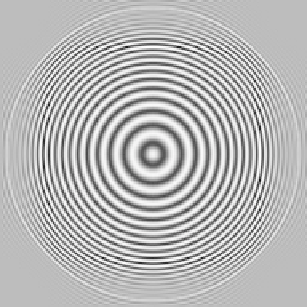Image Processing Reference
In-Depth Information
Fig. 9.6. Lowpass filtering on a test image using both a Gaussian and a sinc.
Left
: filtering
using a 2D Gaussian, with
σ
=0
.
75, corresponding to the black graph in Fig. 9.4.
Right
:
filtering using a 2D Sinc, corresponding to the red graph in Fig. 9.4
Such an operation is frequently needed in image analysis, e.g to change the size of
an image. Both filter families are separable in that they can be implemented as a
cascade of 1D convolutions. However, as illustrated by Fig. 9.6, the sinc filter does
not treat all directions equally when it suppresses high frequencies, introducing arti-
facts. By contrast, the Gaussian filter, being the only filter that is both separable and
rotation-invariant, does not suffer from this.
Example 9.4. Here we illustrate the process of down- and up-sampling of an image
by using Gaussians as interpolation functions.
•
In Fig. 9.7 we show a graph representing an image where red x-marks represent
pixels. The image will be reduced by a factor of 2. At every second row and col-
umn, a blue ring shows where the interpolation functions are placed and a scalar
iscomputedbythescalarproductofthelocalimageandtheinterpolationimage.
These scalars represent the pixel values of the reduced image. The concentric
magenta rings show the isovalues of the interpolation function. The rings show
the loci where the (continuous) interpolation function, with
σ
=0
.
8, reaches 0.5
(dashed) and 0.01 (solid) levels, respectively. The interpolation function can be
sampled at points marked with
×
, and it can be truncated at the level of the solid
magenta ring.
•
In Fig. 9.8 we show another drawing representing an image that has been en-
largedbyafactor2.Theredx-marksrepresentthepixelscopiedfromtheoriginal
(smaller)image,whereasateverysecondrowandcolumn,thebluedotsmarkthe
pixels that are initially put to zero. The interpolation function convolves this im-
age to deliver the final enlarged image, via local scalar products. The concentric
magenta rings show the isovalues of the interpolation function. The rings show



